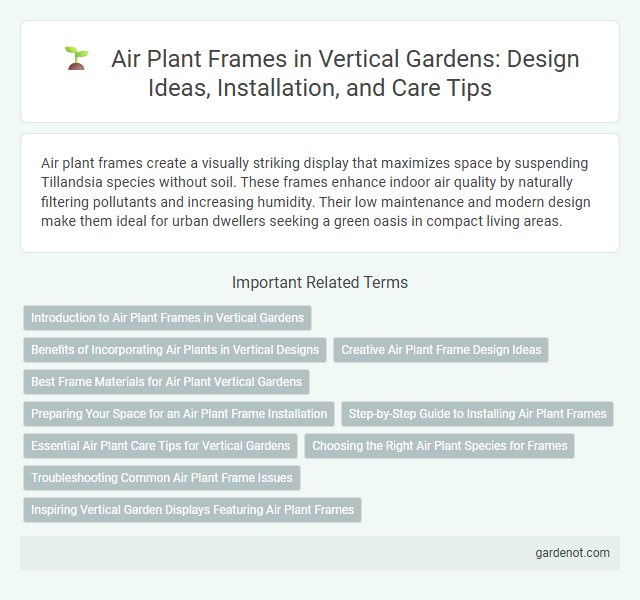Air plant frames create a visually striking display that maximizes space by suspending Tillandsia species without soil. These frames enhance indoor air quality by naturally filtering pollutants and increasing humidity. Their low maintenance and modern design make them ideal for urban dwellers seeking a green oasis in compact living areas.
Introduction to Air Plant Frames in Vertical Gardens
Air plant frames are innovative structures designed to showcase tillandsias, or air plants, in vertical gardens without soil. These frames maximize space efficiency and enhance indoor air quality by supporting the natural filtering abilities of air plants. Incorporating air plant frames into vertical gardens creates a visually striking, low-maintenance green wall perfect for modern living spaces.
Benefits of Incorporating Air Plants in Vertical Designs
Incorporating air plants in vertical garden frames enhances indoor air quality by naturally filtering pollutants and producing oxygen. Their minimal soil requirements and lightweight structure allow for easy maintenance and flexible design configurations. Air plants also improve aesthetic appeal with their unique textures and vibrant colors, creating dynamic living walls that maximize space efficiency.
Creative Air Plant Frame Design Ideas
Creative air plant frame design ideas include geometric shapes, such as hexagons and triangles, that maximize space utilization while adding modern visual appeal. Incorporating natural materials like reclaimed wood and metal wire enhances the rustic yet contemporary aesthetic and provides a sturdy base for sustainable air plant displays. Utilizing modular frames allows for customizable arrangements, making it easy to refresh vertical gardens with vibrant, low-maintenance Tillandsia varieties.
Best Frame Materials for Air Plant Vertical Gardens
The best frame materials for air plant vertical gardens include natural wood, metal, and wire mesh, as they provide sturdy support and promote proper airflow essential for air plant health. Treated cedar and teak are popular wooden choices due to their durability and resistance to moisture and insects in vertical garden setups. Metal frames, especially powder-coated steel or aluminum, offer longevity and minimal maintenance while ensuring a sleek modern aesthetic for indoor and outdoor air plant displays.
Preparing Your Space for an Air Plant Frame Installation
Choose a well-lit area with indirect sunlight to optimize air plant growth and health. Ensure the chosen wall or surface is sturdy enough to support the weight of the air plant frame without damage. Clear the space from dust and debris to promote cleaner installation and better adherence of mounting materials.
Step-by-Step Guide to Installing Air Plant Frames
Begin by selecting a sturdy air plant frame made of natural materials like wood or metal for optimal durability and aesthetic appeal. Secure the frame to a wall using anchors and screws, ensuring it is level and firmly attached to support the weight of the plants. Carefully insert air plants into the frame's slots or pockets, allowing adequate space for airflow and easy watering, then mist the plants regularly to maintain humidity.
Essential Air Plant Care Tips for Vertical Gardens
Air plant frames thrive in bright, indirect sunlight, making them perfect for vertical garden displays that maximize space and aesthetics. To ensure healthy growth, mist air plants with water two to three times a week or soak them for 20-30 minutes every 10 days, allowing complete drying before placing them back in the frame. Proper air circulation and occasional fertilizer application support vibrant, resilient air plants within vertical garden setups.
Choosing the Right Air Plant Species for Frames
Selecting the right air plant species for vertical garden frames involves considering factors such as size, light requirements, and growth habits. Tillandsia ionantha and Tillandsia xerographica are popular choices due to their compact size and adaptability to indirect light, making them ideal for vertical frames. Ensuring proper airflow and minimal watering helps maintain the health and longevity of air plants in frame arrangements.
Troubleshooting Common Air Plant Frame Issues
Air plant frames may encounter issues such as poor air circulation, leading to mold growth or rot on the plants. Ensuring the frame allows adequate airflow and removing excess moisture can prevent these problems. Inspecting for damage or loose mounts on the frame helps maintain plant health and stability.
Inspiring Vertical Garden Displays Featuring Air Plant Frames
Air plant frames transform vertical garden displays by showcasing Tillandsia species without soil, emphasizing minimal maintenance and modern aesthetics. These frames enhance indoor air quality while serving as living art pieces that can be customized with various shapes and sizes. Incorporating air plant frames into vertical gardens creates dynamic, space-saving designs ideal for apartments, offices, and small urban environments.
Air plant frame Infographic

 gardenot.com
gardenot.com